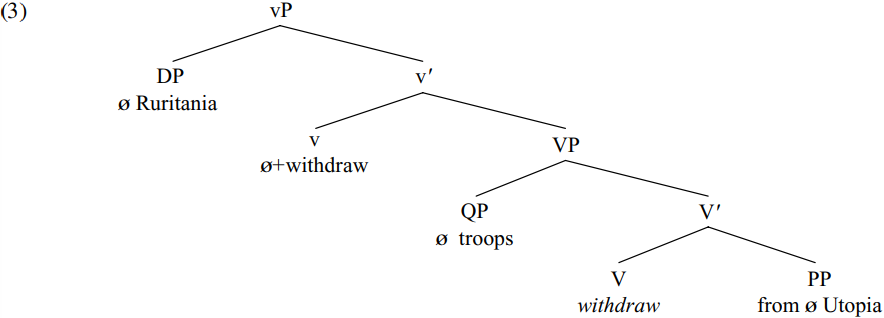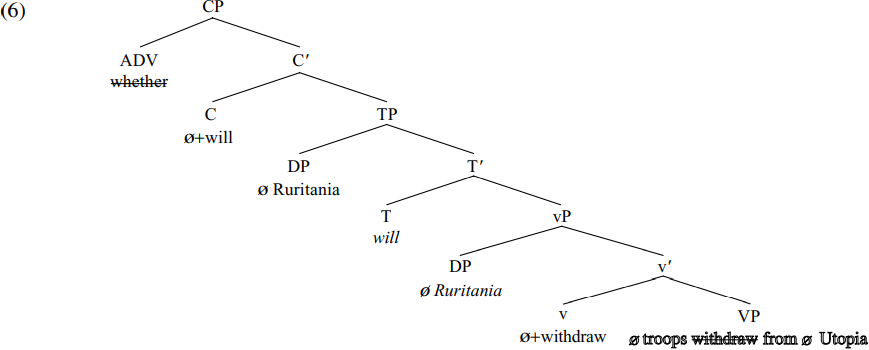
Phases
 المؤلف:
Andrew Radford
المؤلف:
Andrew Radford
 المصدر:
Minimalist Syntax
المصدر:
Minimalist Syntax
 الجزء والصفحة:
381-10
الجزء والصفحة:
381-10
 2023-02-15
2023-02-15
 3154
3154
Phases
We outlined Chomsky’s claim in recent work that all syntactic operations involve a relation between a probe P and a local goal G which is sufficiently ‘close’ to the probe (or, in the case of multiple agreement, a relation between a probe and more than one local goal). We noted Chomsky’s (2001, p. 13) remark that ‘the P, G relation must be local’ in order ‘to minimize search’, because the Language Faculty can only hold a limited amount of structure in its ‘active memory’ (Chomsky 1999, p. 9). Accordingly, syntactic structures are built up one phase at a time. Chomsky suggests (1999, p. 9) that phases are ‘propositional’ in nature, and include CP and transitive vP (more specifically, vP with an external argument, which he denotes as v∗P). His rationale for taking CP and v∗P as phases is that CP represents a complete clausal complex (including a specification of force), and v∗P represents a complete thematic (argument structure) complex (including an external argument).
Once all the operations which apply within a given phase have been completed, the domain of the phase (i.e. the complement of its head) becomes impenetrable to further syntactic operations. As we have already seen, Chomsky refers to this condition as the Phase Impenetrability Condition/PIC – and we can state it informally as follows (cf. Chomsky 2001, p. 5, ex. 6)

The reason why the domain of the phase head is impenetrable to an external probe (according to Chomsky 2001, p. 5) is that once a complete phase has been formed, the domain of the phase undergoes a transfer operation by which the relevant (domain) structure is simultaneously sent to the phonological component to be assigned an appropriate phonetic representation, and to the semantic component to be assigned an appropriate semantic representation – and from that point on, the relevant domain is no longer accessible to the syntax. So, for example, once a complete CP phase has been formed, the TP which is the domain (i.e. complement) of the phase head C will be sent to the phonological and semantic components for processing. As a result, TP is no longer visible in the syntax, and hence neither TP itself nor any constituent of TP can subsequently serve as a goal for a higher probe of any kind: i.e. no probe c-commanding CP can enter into a relation with TP or any constituent of TP.
In order to make our discussion more concrete, consider the derivation of the following sentence:

Given Chomsky’s vP+VP analysis of transitive verb phrases (which we shall adopt throughout here, setting aside Bowers’s vP+TrP+VP analysis), (2) will be derived as follows. The verb withdraw merges with its complement from Utopia (with Utopia being a DP headed by a null determiner, given the DP hypothesis) and its specifier troops (which is a QP headed by a null partitive quantifier ø) to form the VP ø troops withdraw from ø Utopia. This is then merged with a causative light verb whose external AGENT argument is Ruritania (another DP headed by a null determiner): since the light verb is affixal, it triggers movement of the verb withdraw from its original (italicized) position in V to v, so deriving (3) below:

The light verb will agree with (and assign accusative case to) the QP ø troops. Since a transitive vP (i.e. a vP with an external argument) is a phase, and since the vP in (3) is transitive and has the external argument ø Ruritania, the VP constituent (by virtue of being the domain/complement of the light verb which is the head of the phase) will undergo transfer to the phonological and semantic components at this point, and thereafter cease to be accessible to further syntactic operations. Let’s suppose that as part of the transfer operation, traces are marked as having a null spellout in the phonological component (this being indicated by strikethrough), and that uninterpretable features which have been deleted by operation of agreement are removed from the structure handed over to the semantic component, but not from the structure handed over to the phonological component. Consequently, the phonological component will not spell out the trace of the verb withdraw in V, and only the constituents ø troops and from Utopia will be given an overt phonetic spellout.
The syntactic computation then proceeds once more, with [T will] being merged with the vP in (3) to form the T-bar shown below (outline font being used to indicate those parts of the structure which received an overt or null spellout in the phonological component after the VP underwent transfer at the end of the vP phase, and strikethrough marking traces receiving a null spellout):

Since [T will] has uninterpretable (and unvalued) person/number features, it is an active probe which searches for a local goal to value and delete its unvalued features. Neither ø troops nor ø Utopia are accessible to the probe will (since both are contained within a VP which has already been transferred to the phonological and semantic components); however, the DP ø Ruritania is accessible to will and is syntactically active by virtue of its uninterpretable case feature. Hence, will agrees (invisibly) with and assigns (invisible) nominative case to the DP ø Ruritania. The auxiliary [T will] also has an [EPP] feature requiring movement of the closest matching goal to spec-TP; accordingly, the DP ø Ruritania is moved from its original (italicized) position in spec-vP to become the specifier of will, so deriving the structure:

The resulting TP is merged with a null interrogative C. Let’s suppose that yes–no questions contain a null yes–no question operator in spec-CP (e.g. a null counterpart of the adverb whether), and that C is strong/affixal and attracts will to move from its original (italicized) position in T to adjoin to the null C heading CP. If so, at the end of the CP cycle we will have the structure (6) below:

Since CP is a phase and the domain of the head of a phase is spelled out at the end of a phase, TP undergoes transfer to the phonological and semantic components at this point. The transfer operation results in the italicized traces of will and ø Ruritania receiving a null spellout in the phonological component.
However, we are now left with something of a problem. We have come to the end of the derivation, but so far neither C nor the null yes–no question operator which serves as its specifier have been ‘handed over’ to the phonological and semantic components for further processing. In order to ensure that this happens, let’s make the additional assumption in (7ii) below about transfer:

In the case of (6), the two remaining constituents which have not yet undergone transfer are those at the edge of CP (the edge of a projection comprising its head and any specifiers/adjuncts it has) – i.e. the C-constituent containing will and the null yes–no question operator in spec-CP. Accordingly, these undergo transfer to the phonological/semantic components at the end of the overall derivation.
 الاكثر قراءة في Syntax
الاكثر قراءة في Syntax
 اخر الاخبار
اخر الاخبار
اخبار العتبة العباسية المقدسة


